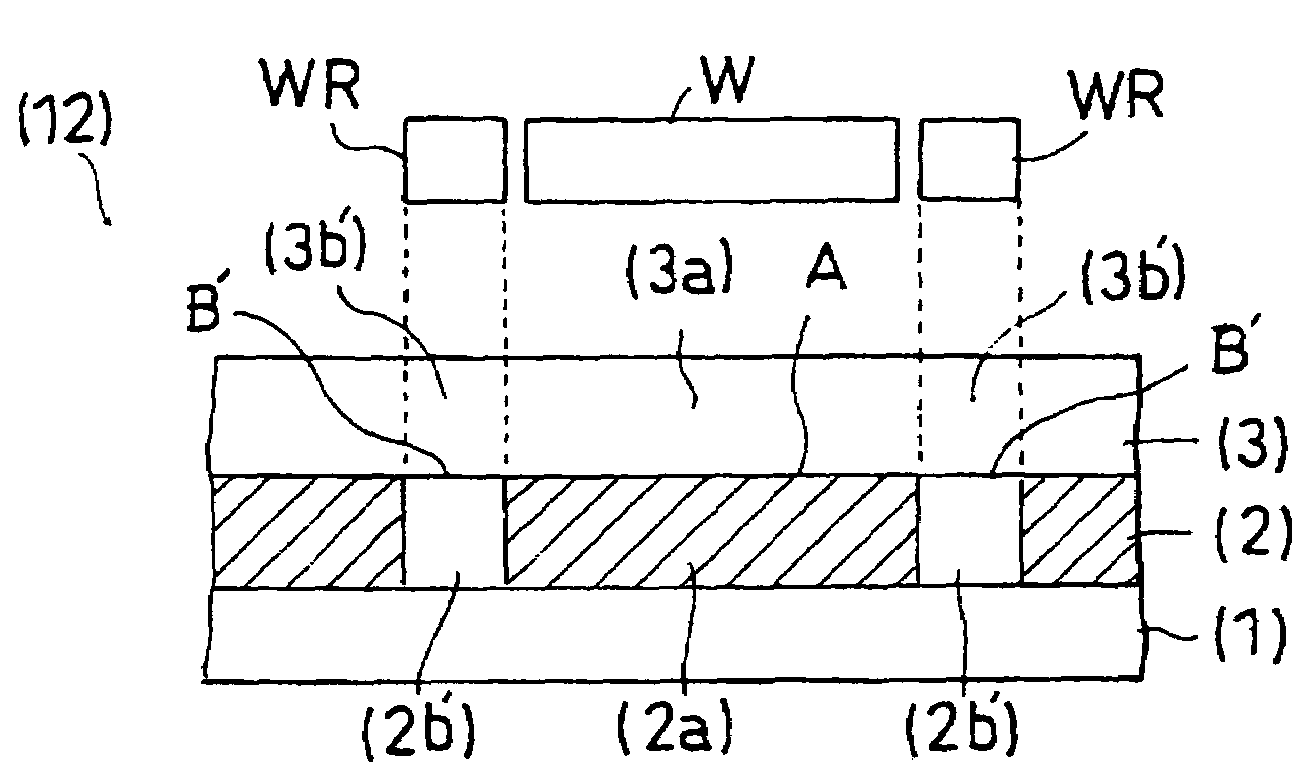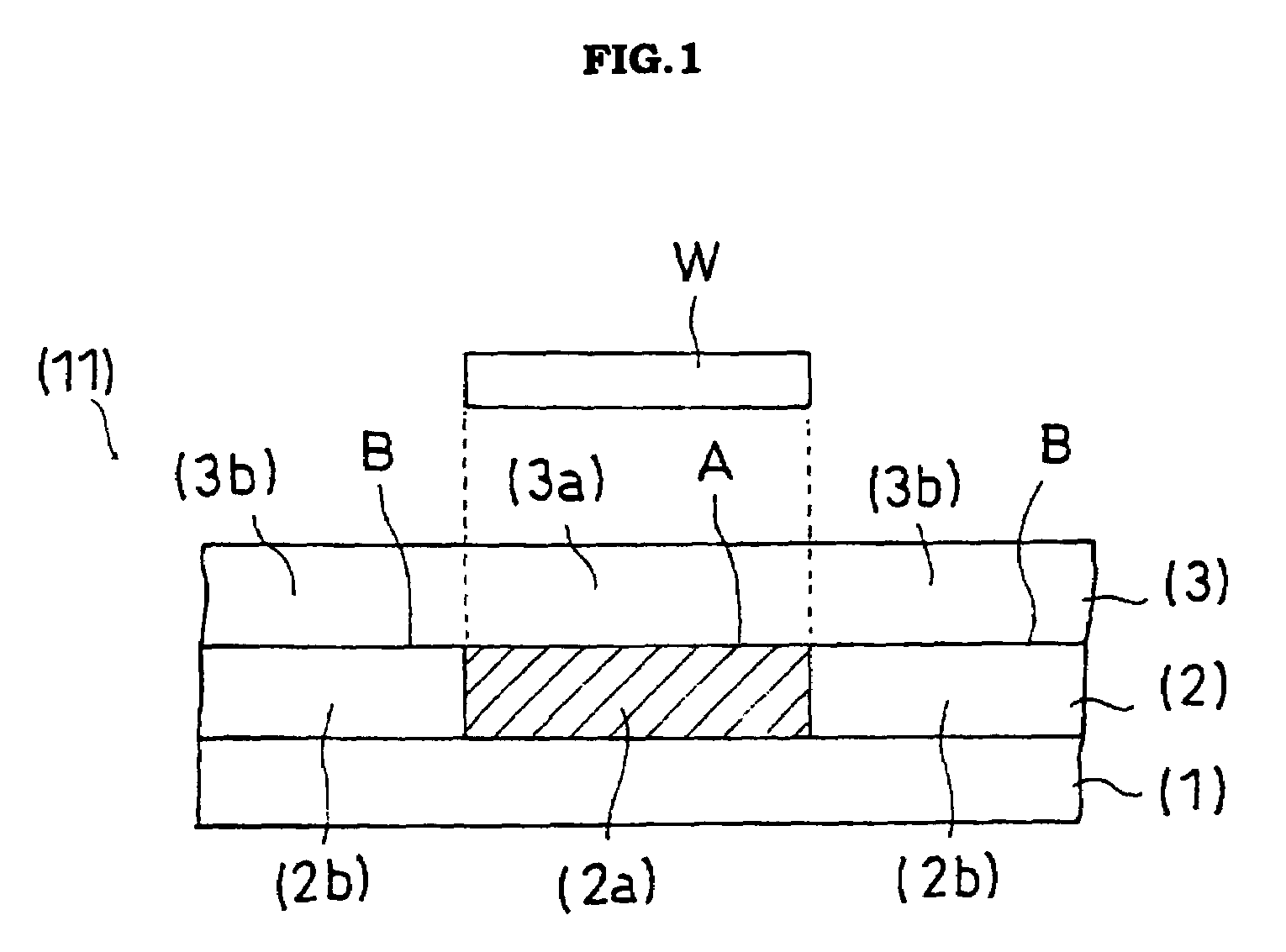Dicing die-bonding film
a die-bonding film and die-bonding technology, applied in film/foil adhesives, semiconductor/solid-state device details, animal husbandry, etc., can solve the problems of hardly uniform application of adhesive layers, time-consuming and special devices for adhesive application, and hardly balanced two features
- Summary
- Abstract
- Description
- Claims
- Application Information
AI Technical Summary
Benefits of technology
Problems solved by technology
Method used
Image
Examples
production example 1
(Substrate Material)
[0101]As the substrate material, linear low-density polyethylene of 70 μm in thickness was used. One side of this film was subjected to corona treatment.
(Preparation of Radiation-Curing Acrylic Pressure-Sensitive Adhesive)
[0102]70 parts of butyl acrylate (Tg in homopolymer, −55° C.), 30 parts of ethyl acetate (Tg in homopolymer, −21° C.) and 5 parts of acrylic acid (Tg in homopolymer, 106° C.) were copolymerized in a usual manner in ethyl acetate to give a solution of an acrylic polymer at a concentration of 30 wt % having a weight-average molecular weight of 800,000. The glass transition temperature of the acrylic polymer was −4.5° C. To this acrylic polymer solution were added 20 parts of dipentaerythritol monohydroxy pentaacrylate, 3 parts of a photopolymerization initiator (trade name: Irgacure 651, manufactured by Ciba Specialty Chemicals Inc.), 0.5 parts of an epoxy compound (trade name: Tetrad C, manufactured by Mitsubishi Gas Chemical Company, Inc.) and 2...
production example 2
(Substrate Material)
[0104]A polyethylene film of 80 μm in thickness was used as the substrate material.
(Preparation of Radiation-Curing Acrylic Pressure-Sensitive Adhesive)
[0105]A composition consisting of 50 parts by weight of ethyl acrylate (Tg in homopolymer, −21° C.), 50 parts of butyl acrylate (Tg in homopolymer, −55° C.) and 16 parts of 2-hydroxyethyl acrylate (Tg in homopolymer, −25° C.) were copolymerized in toluene to give a solution of an acrylic polymer at a concentration of 30 wt % having a weight-average molecular weight of 500,000. The glass transition temperature of the acrylic polymer was −37.5° C. This acrylic polymer solution was subjected to addition reaction with 20 parts of 2-methacryloyloxyethyl isocyanate to introduce a carbon-carbon double bond to a side chain of the polymer molecule. 100 parts (solids content) of this polymer was further compounded with 2 parts of a polyisocyanate-based crosslinking agent (trade name: Colonate L, manufactured by Nippon Polyu...
production example 3
(Substrate Material)
[0107]A polyethylene film of 80 μm in thickness was used as the substrate material.
(Preparation of Radiation-Curing Acrylic Pressure-Sensitive Adhesive)
[0108]A composition consisting of 95 parts of 2-ethylhexyl acrylate (Tg in homopolymer, −85° C.) and 5 parts of acrylic acid (Tg in homopolymer, 106° C.) was copolymerized in an ethyl acetate solution to give a solution of an acrylic polymer at a concentration of 30 wt % having a weight-average molecular weight of 700,000. The glass transition temperature of the acrylic polymer was −65.2° C. To this acrylic polymer solution were added 130 parts of a radiation-curing oligomer (viscosity at 25° C., 10 Pa·sec) obtained by reacting dipentaerythritol acrylate with diisocyanate, 3 parts of a photopolymerization initiator (trade name: Irgacure 651, manufactured by Ciba Specialty Chemicals Inc.) and 5 parts of a polyisocyanate compound (trade name: Colonate L, manufactured by Nippon Polyurethane Industry Co., Ltd.), where...
PUM
| Property | Measurement | Unit |
|---|---|---|
| adhesion | aaaaa | aaaaa |
| tensile storage elastic modulus | aaaaa | aaaaa |
| peel angle | aaaaa | aaaaa |
Abstract
Description
Claims
Application Information
 Login to View More
Login to View More - R&D
- Intellectual Property
- Life Sciences
- Materials
- Tech Scout
- Unparalleled Data Quality
- Higher Quality Content
- 60% Fewer Hallucinations
Browse by: Latest US Patents, China's latest patents, Technical Efficacy Thesaurus, Application Domain, Technology Topic, Popular Technical Reports.
© 2025 PatSnap. All rights reserved.Legal|Privacy policy|Modern Slavery Act Transparency Statement|Sitemap|About US| Contact US: help@patsnap.com



